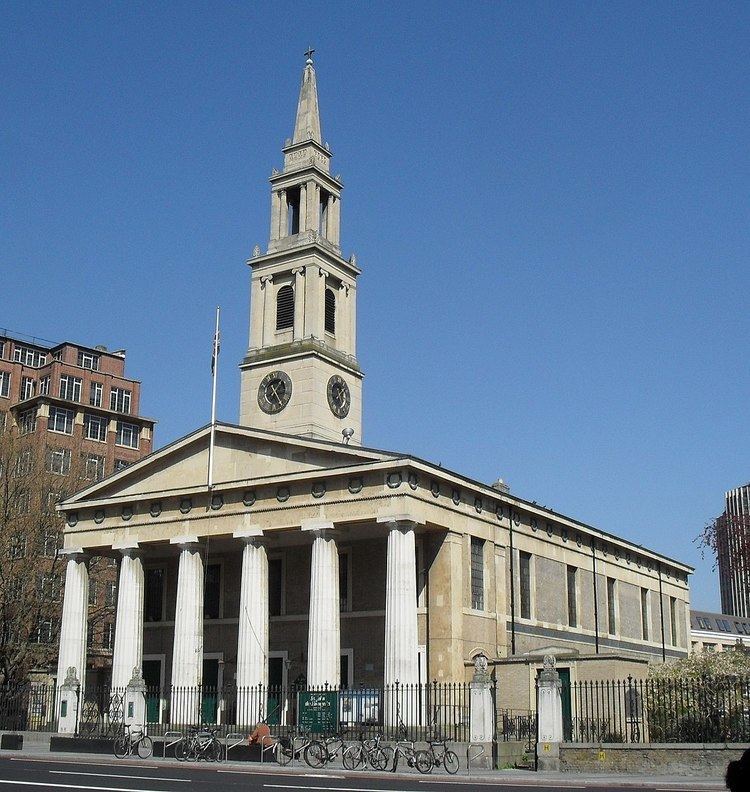Website stjohnswaterloo.org Phone +44 20 7633 9819 | Founded 1822 | |
 | ||
Deanery Lambeth North tube station Similar St Mark's Church - Kennington, St Luke's Church - West Nor, St Matthew's Church - B, Christ Church - Lambeth, St John the Divine - Kennington Profiles | ||
unalone thursday 1st of december 2 00pm at st john s church waterloo london
St John's Church, Waterloo, is an Anglican Greek Revival church in South London, built in 1822–24 to the designs of Francis Octavius Bedford. It is dedicated to St John the Evangelist, and with St Andrew's, Short Street, forms a united benefice.
Contents
- unalone thursday 1st of december 2 00pm at st john s church waterloo london
- Location
- History
- Today
- References
Location
The church is located in Waterloo, opposite the London IMAX, close to Waterloo station and the Waterloo campus of King's College London. In 1818, when the country was settling down into a period of peace after the Napoleonic Wars and the population was beginning to expand rapidly, Parliament decided to allocate a sum not exceeding a million pounds for the building of additional churches in populous parishes and “more particularly in the Metropolis and its Vicinity.” Of this sum, the Commissioners for Building New Churches appropriated £64,000 in 1822 for the needs of the parish of Lambeth. It was decided that a new church should be built on the Waterloo Bridge approach, with a piece of ground on the east side of the road to be purchased from the Archbishop of Canterbury and his lessee and the sub-lessee, Gilbert East and a man named Anderson.
History
The Church of St John was built to the designs of the architect Francis Octavius Bedford in 1824. Bedford designed three other churches for the Commissioners, St George’s, Camberwell, St Luke, West Norwood and Holy Trinity, Newington. They were all built in the same Greek style inspired by Bedford’s background as a well-respected Greek scholar and antiquarian. Bedford’s churches were fiercely criticised by contemporary critics at a time when the tide was turning away from the Greek revival towards Gothic. St John’s however gained more critical appreciation mainly because of its fine spire which used classical detail to build up a more traditional English parish church shape.
The ground was very swampy, consisting in part of a pond, and the advice of John Rennie was sought as to the most suitable type of foundation. His recommendation that piling should be used under all the walls was adopted with such success that, after the lapse of 125 years, heavy damage by bombing and ten years' exposure to the weather, the walls were still strong and sound enough to be used in the renovated church.
The Church was renovated by Blomfield in 1885 and altered internally by Ninian Comper in 1924. The Church was struck by a bomb in 1940, when the roof and much of the interior was destroyed. The building stood open for ten years until it was restored and remodelled internally by Thomas Ford in 1950. In 1951 the Church was rededicated as the Festival of Britain Church.
Thomas Ford removed the galleries and a new decorative scheme was installed using Greek ornamental motifs, gilt and light pastel shades. A mural by Hans Feibusch was commissioned and replaced the damaged Victorian reredos. The overall effect is vastly different from the essentially Victorian interior that previously existed. The highlights of decorative detail and colour are typical of a tradition evolved by Thomas Ford through the 1930s and into the 1950s.
During the construction of the Jubilee line, the structural stability of the church was closely monitored as the soil underneath the church began to dry out as a result of the building of the new London Underground line. Still supported by the piles driven into the marshy soil in 1824, millions of gallons of water had to be pumped into the foundations of the church to prevent its collapse as a result.
Today
The church that exists today is a thriving multicultural congregation that has developed strong links with the local community. There is a choir under the musical direction of Andy Thomas. The church also hosts the Okusinza Church, which is a Luganda language church with a mainly Ugandan congregation. The church also holds a very strong link to Fairtrade products with stalls outside the Church selling items from Monday – Friday every week, in tandem with a Food Court.
